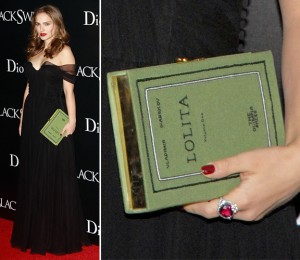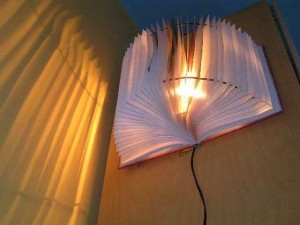You have no items in your cart. Want to get some nice things?
Go shopping
When Natalie Portman walks into a room, I can only imagine the number of heads that turn: undeniably beautiful, she’s an Oscar-winning actress, a graduate of the prestigious Harvard University, face of Miss Dior Cherie and recently gave birth to her first child. But when I saw photos of her, a few months ago, at the New York Premiere of Black Swan, I barely glanced at her, nor did I bother reading the review of the film; instead, all I could look at was her clutch bag, a quirky and utterly gorgeous design by Olympia Le Tan made out of a hardback copy of Vladimir Nabokov’s Lolita.
For me, a known handbag-addict and bookworm, the Lolita clutch seemed like the Holy Grail of accessories. Of course, when I googled the clutch, it was retailing at a cool $1300, slightly out of my price range, to say the least. Luckily, I wasn’t the only literary fashionista inspired by the Lolita clutch and various clever, crafty types started to upload ‘how to’ videos, so that one could turn an old book into a beautiful bag in the comfort of your own home and for only a fraction of the price.
And backpacks for school bags aren’t the only option for book-lovers hoping to turn an old, mildewing classic into something new and useful! A little more research on Google provided me with a whole host of ideas of how to recycle and reinvent your old books. For the literature fanatic looking to redecorate their homes, why not try a unique paper lamp shade made out of the pages of your favourite tome (remember to use a low wattage bulb!) or create a book wreath just in time for the festive season? Indeed, with Christmas just around the corner, a couple of websites suggested hollowing out hardcover novels and using them as gift boxes – you could even use the discarded pages as wrapping paper for small individual gifts. For the home with too many books, and not enough space for them, how about putting up some original floating book shelves? It seems that old books can be turned into anything – necklaces, artwork, safe deposit boxes, tables, wall-clocks – just look for it on the internet and you’ll find a step-by-step tutorial.

It’s not a wholly new idea – altering books with impromptu artwork and cutting out clippings was prevalent in the Victorian period and, today, ‘altered books’’ has become an art form. The International Society of Altered Books Artists describes the processes that the artists use in order to create their sculptures, classifying an ‘altered book’ as: “Any book, old or new that has been recycled by creative means into a work of art. They can be … rebound, painted, cut, burned, folded, added to, collaged in, gold-leafed, rubber stamped, drilled or otherwise adorned …” Interest in this up-and-coming art form has increased and, in 2009, the Bellevue Arts Museum in the US held an exhibition, entitled The Book Borrowers, containing 31 works dedicated to ‘altered books’ artists.
So there I was, with an old hardcover edition of an E.M. Forster novel in one hand and a scalpel in the other, poised and ready to make my own fabulous clutch. But I just couldn’t do it: I couldn’t bring myself to hack at the delicate pages and tear them from the spine. Although many of my books have seen better days, in their own way, they are art – the work inside them is an art form at least, and pulling apart that carefully crafted narrative just doesn’t seem right. Destroying books, or bibliocide, is a sensitive topic – some would say that true bibliophiles would never dream of attacking literature in such a thoughtless way.
But in today’s society, where the new generation of readers clutch their Kindles and box after box of neglected books are dumped outside the charity shop, only to then fester on their shelves, isn’t using texts in this way a positive thing? The artists argue that altered books give the novel new cultural meanings and make them relevant in society again. Should we view book altering as recycling, rather than destroying? Could you make a handbag out of a hundred year old tome?
Personally, I love literary-inspired gifts and accessories. I own quite a lot of the Penguin Publishing merchandise – mugs, postcards, tote bag – and I can really appreciate the time, effort and craft that goes into turning a book into a sculpture or a beautiful wall lantern. Taking a knife, however, to an antique book is not something I am able to do myself. Don’t get me wrong, there a plenty of novels that I think aren’t worth the paper they’re printed on but I’m not sure I could even take the most poorly written story apart. Books are special and, in my view, ought to be treated with tender loving care.
So should books become bags or remain just books? I’m undecided but, I will say, that if anyone has a spare one thousand dollars lying around, I’d happily accept one of the beautiful Olympia le Tan clutches – if it’s good enough for Natalie Portman, then it’s good enough for me.
Briony Wickes




